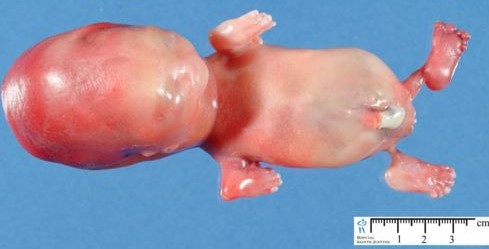Sacral Agenesis
What is sacral agenesis?
Sacral region is the part of the upper last segment of the vertebral column. The location of this region is near to the pelvic region. In sacral agenesis, completely or partially sacral region is missing. Sacral region alternatively termed as , as the lower part of the body is impaired formation. This is a congenital anomaly and this affects the lower parts of the body, including lower portion of the back and leg, gastrointestinal organs and genitor-urinary organs.

Symptoms of sacral agenesis
The symptoms are based on which organ/ organs are mostly affected. The sign and symptoms are varied with an individual child, the early notification is very important and encourage child to speak about their difficulties with doctors. In rare cases sacral agenesis asymptomatic. The different clinical features obtained in sacral agenesis are as follows:
Structural deformity in pelvic region
The lumber, sacral and cocygeal are adjoined and lower back and pelvic deformity are one of the most common symptoms which includes
- Narrow hips
- Underdeveloped gluteal muscles (buttock muscle)
- A notch found on the lower back skin surface
- Buttock becomes flattened
Neurological problems
The spinal nerves exit from the sacral region and provide impulses to different organs. The sacral agenesis is also causing malfunctioning of the spinal nerve and affects the different organ functionality. This includes
- Faulty urinary bladder and bowel control,
- Polyurea,
- Incomplete bladder emptying,
- Chronic constipation
- Obstructed bowel
- Dysfunctionality of the urinary tract
- Sepsis in perianal region
- Neuro-enteric cyst formation
- Vertebral tethering
Deformities on lower limbs
Degenerative neurological effects affect lower limb which includes:
- Muscle shortening of the knee and hip leads to flexion contractures
- Completely or partially stiffened the affected joint
- Immobility of the affected part
- Muscle mass reduction can lead to popliteal ptergyium (webbed of cutaneous tissue found behind the knee)
Renal abnormality
Renal abnormality is quite common symptoms of sacral agenesis and it causes different urinary organs related problems which include:
- Renal agencis (absence of one kidney)
- Abnormal positioning of the kidney,
- Renal insufficiency
- Urinary tract dysfunction
- Fused tubing of the urinary tract
- Obstructed urine flow
- Backward flow of urine from uterus to urinary bladder (vesicoureteral reflux)
- Malformation of gynecological part
Meningitis or related problems
Meningitis or meningomyelocele may develop in some patient which causes degenerative changes in the covering of the spinal nerves.
Other physiological abnormalities
Other possible physiological findings are as follows:
- Aberration of the upper spine,
- Facial abnormalities like cleft palate, cleft lip
- Imperforate anus or anal atresia is a condition where a thin membrane is formed and obstructs the anal passage which is bridging the rectum and anus.
Causes
Sacral agenesis considered as an autosomal genetic disorder. The exact reason behind the development of sacral agenesis is unknown. It is considered that the multiple factors are involved in the development of sacral agenesis.
- The evidence shows that the incidence rate is comparatively high in case of insulin dependent diabetic mother deliver the fetus with sacral agenesis. The elevated blood sugar and associated metabolic disorder causes sacral agenesis in the fetus, especially in case of poorly managed hyperglycemic mothers.
- Disruption of fetus growth in the 28 days of pregnancy causes deformation of the mesoderm, the middle layer of the embryo. Mesoderm deformity leads to defects in the skeletal system, genitourinary system and gastro-intestinal system.
- Other possible cause is abnormal circulation in an abdominal artery, which leads to restricted flow of blood in the lower part of the fetus body. Absence of sufficient blood flow causes impaired tissue generation and tissue necrosis.
- Some researchers believe mesoderm impairment leads to restricted blood flow and develop sacral agenesis.
Diagnosis
- The prenatal ultrasound helps to diagnose the sacral agenesis syndrome before birth of the child.
- For confirmatory test, high-frequency sound waves are used in advanced ultrasound techniques to get clear images of the fetus development.
- Echocardiography is conducted for checking the involvement of the heart.
- MRI helps to detect the spinal abnormalities.

Treatment
Treatment is based on the symptomatic control. The treatment process is not performed by one clinician. To treat this condition, Team of clinical experts is required.
The team mainly contains pediatricians, neurologists, orthopedists, cardiologists, urologists, nephrologists, neurosurgeons, orthopedist surgeons and other medical and paramedical staff.
This team firstly chalks out the treatment plan and accordingly treats the patient depending upon the patient response. The treatment plan is usually complex and contains various surgical interventions, including urological, cardiologic, spinal, and limb surgery.
Anticholinergic drugs can prescribed for some patients to regulate urinary complications.
The treatment plan is not same for all the patients, as the severity and the prognosis is varying with individual to individual.
Early diagnosis can provide maximum potentiality to the child. It is also suggested that psychological counseling, physiotherapy and vocational training help for rehabilitation of the child physically, socially as well as mentally.
References
- http://jmg.bmj.com/content/37/8/561.full
- http://www.cafamily.org.uk/medical-information/conditions/s/sacral-agenesis/
- http://rarediseases.org/rare-diseases/caudal-regression-syndrome/
- http://ghr.nlm.nih.gov/condition/caudal-regression-syndrome
- http://www.medicinenet.com/script/main/art.asp?articlekey=12975
